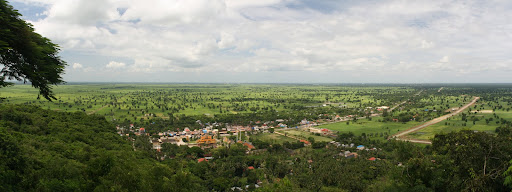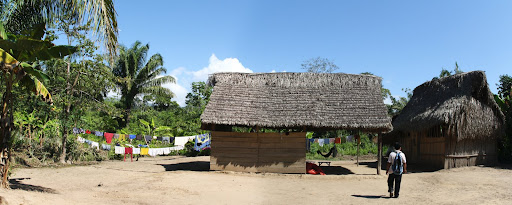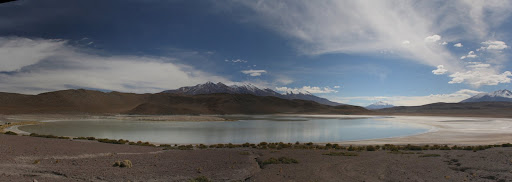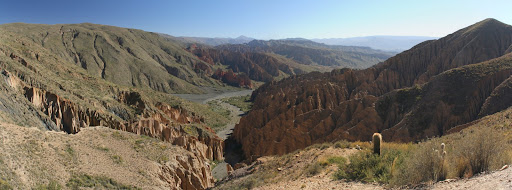We decided to only make two major stops in Cambodia since our visit was a mere ten days in length. Battambang, Cambodia’s second largest city at 140,000 was our second destination. The city has some nice colonial buildings but the main attractions lie a short tuktuk ride outside of town.
The fastest way to Battambang from Siem Reap is to take the bus. A more interesting but slower and more expensive way of making the trip is by boat. The trip started with a van transfer from our guesthouse in Siem Reap to the boat docks on the shore of Tonlé Sap Lake. I think this part of the trip is usually pretty fast but we had to forge some pretty deep door-seal-testing flood waters along the way. Ironically, the flood waters also cut our boat journey short at the other end of the trip as our boat was unable to pass under some of the bridges near Battambang.
At some point on the river, we broke down. I think this is par for the course on this ride; the guidebooks warn about it. This time one of the steering cables broke but our crew fashioned a splice out of a pair of knock-off vice grips. The breakdown was actually nice because for once we could enjoy the peace and quiet of the river. Best I could tell, our boat had a very minimal exhaust system – straight pipes seem likely. All I know is that it was really loud whenever the engine was running!
Eventually we entered the delta of the Stung Sangker river and passed a number of floating villages. They are quite a remarkable sight. Pretty much everything: houses, gas stations, stores and schools are floating. Some of the houses even had floating pigpens and chicken coups. The only permanent structures I could spot were the numerous cellular phone towers anchored to cement pylons.
Once we arrived in Battambang we tuktuked into town (an extra 8 kilometers thanks to the flooding) and found a nice room at the Lux Guesthouse for $18 per night. Surprisingly enough, we heard that Battambang had some good vegetarian restaurants. Starving from the boat ride we immediately went and checked one of them out (Mercy House). Faux meat dishes aplenty on the menu and those proved to be one of my favorite things to eat during our three night stay in Battambang. Lunch or dinner for two people came to $5 on average. Great food at a cheap price.
The big thing to do when visiting Battambang is a tuktuk tour of the surrounding countryside. The tuktuk driver who picked us up at the boat seemed like a nice guy but despite emailing and calling I couldn’t reach him to scheduled a tour. Instead, we ended up with one of the guys who works for our guesthouse.
One of the first stops on our day tour was the bamboo train. Although there are plans to revitalize it, the Cambodia railroad system is currently defunct. This hasn’t stopped the locals from continuing to make use of the tracks. Makeshift bamboo carts with small engines are used to transport people, goods and tourist along the tracks in this part of the country. The carts are easy to disassemble so anytime another “train” is encountered the one with the lighter load must yield the way. Apparently these were also used when real trains were plying the tracks!
We blasted a few kilometers down the tracks at what felt like a very high rate of speed. The train tends to scare the insects living in the grass around the rails so you are constantly pelted with grasshoppers and the like along the way. Amy wasn’t too fond of this!
Next we drove to Phnom Banan, a temple perched nicely on a hill surrounded in pancake-flat brilliantly green rice fields. From the dropoff point it is a 358-step climb to the temple which was a good way to work up a sweat in the Cambodian heat.
The final stop of the tour was at the killing caves of Phnom Sampeau. The Khmer Rogue dumped hundreds of bodies in these caves and nowadays the site has been converted into a memorial. After the climb to Phnom Banan we weren’t too keen on climbing another mountain so we hopped on the back of a couple of motorcycles.
I spent quite some time chatting with one of the motorcycle drivers. He was a young kid, maybe in his late teens and his goal was to become a tuktuk driver like the one who was showing us around that day. He explained that it is a very highly paying job – they earn approximately $15 for a day tour. They usually spend one day searching for a customer and then spend the next touring with them; at least that is the way it can be in high season. It doesn’t sound like much money but in Cambodia it is way above the average.
He told me that he had to leave school prematurely in order to help his parents run their restaurant near the killing caves. He takes tourists up the mountains as a side job to help support the family and to save for a tuktuk. What struck me about this guy was his mastery of English – much better than most Cambodians we met during our visit. I complimented him on it and we left him a nice tip for showing us around the caves. I really hope things work out for him.
On our third morning in Battambang we rose early and schlepped our bags over to the bus station to catch a Bangkok-bound bus. Actually, there was no direct bus to Bangkok but we didn’t know that until we were dumped in some obscure town along the road to Poipet. Watching the morning “rush hour” while we waited for our second bus of the day was good entertainment.
At the border things moved very smoothly for us but some of our fellow backpackers apparently had issues leaving Cambodia. Something about their entry visas not being legit – shocking. I think we were waiting on the Thai side of the border for a good hour before they found their way to the minivan. Then we had to wait longer for them to get food because they were starving. Classic. In retrospect, we should have just bought a bus ticket to the border and then a second ticket from the border to Bangkok. Less wait and less hassle!
We had no idea if it would be problematic to get out of Cambodia so we had padded our schedule with an extra day. This left us time to gorge ourselves on more Thai food and run an important errand: buying winter clothing. Next stop, Mongolia.


















